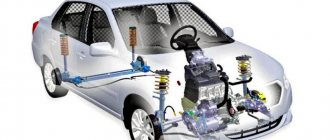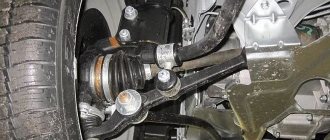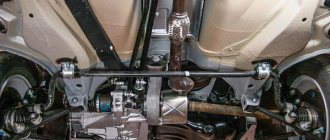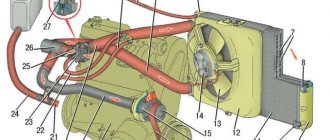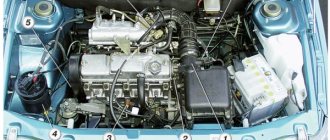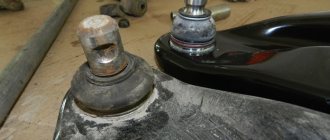The car suspension is designed to level the movement on any type of road surface and provide comfort for the driver and passengers. The presence of vibration for a long time negatively affects all components and assemblies of the car - bolted and screw connections are weakened. Serious consequences include bent door hinges, sagging doors, and loose closure of the hood and trunk.
The chassis of the Lada Granta has become more modern and modernized. Especially in comparison with previous AvtoVAZ models - two generations of Samara and first generation Kalina. The car has rear and front suspensions, which differ significantly from each other.
The rear suspension of the Grant is the same for the sedan and liftback. In fact, this is the same beam with springs and shock absorbers that is installed on Kalina, Samara and Samara 2. Instead of a stabilizer, a beam is used, which means the structure is dependent.
Features of the Granta front suspension
The front suspension is independent, which means that when one of the front wheels falls into a hole, the second one maintains its position. So that when driving on a flat road, both wheels are in the same plane and rotate evenly and parallel to each other, a stabilizer is installed between them. On the front part of the Granta suspension system, the mounting bearing is installed between the shock absorber spring and the body support. As a result, the weight of the machine is completely concentrated on it and keeps it in a compressed position. With this design, the backlash is reduced to zero - extraneous noise disappears.
The independent circuit consists of hydraulic shock absorbers and two wishbones, which are complemented by anti-roll bars. To strengthen the levers, so-called extensions of the upper supports of the front struts are used. They are not installed from the factory, so car owners are forced to install them themselves. The spring has a conical shape, a hydraulic shock absorber is located inside, the pitch of the coils is variable.
The lower part of the rack rests on the steering knuckle. The front suspension is designed in such a way that when the steering wheel rotates, the wheels are turned by the steering knuckle, and the spring and shock absorber turn with them. In this case, the stand of the latter remains in a stationary position. Thanks to this feature, it is possible to increase the service life of shock absorbers.
The designers modernized the block of front strut supports, which made it possible to increase their strength and eliminate squeaks, vibrations and rattling. The anti-roll bar remains unchanged. It is made of hardened steel, attached to the lower arms on the right and left, and rigidly attached to the body in the middle.
Another feature of the updated chassis of the Lada Granta is the increased castor. This is the angle of rotation of the steering wheels, which on Grant is 2° 45`. This solution has both advantages and disadvantages. On the one hand, handling improves; at high speed the car shows a higher level of directional stability. On the other hand, it takes a little more effort to rotate the steering wheel. The steering has also been updated:
- the installed electric power steering has a greater compensating effect;
- a steering rack with a lower gear ratio (short) is used.
The updates have significantly improved the car's handling at different speeds. The steering wheel has become more sensitive, and the number of its revolutions to the full angle of rotation of the steered wheels has decreased due to the short steering rack.
The owners were outraged by the return to using the standard suspension system from Kalina. The steering angle remains the same and no power steering is used. However, this is observed only in minimal configurations.
Advantages and disadvantages
Judging by expert assessments and reviews from ordinary users, the Lada Granta FL suspension has both advantages and disadvantages. Its strengths include:
- Simplicity of design.
- Good maintainability.
- High energy intensity.
The latter feature allows you to operate the car on roads with poor surface quality.
Speaking about weak points, consumers note that there are no significant changes in the car’s behavior on the track. Automobile:
- Does not respond clearly to steering wheel movements.
- Prone to yaw, both on a straight line and in turns.
- It sways on the waves of asphalt and transmits into the cabin the noise that occurs upon contact with the road surface.
In order to at least partially eliminate the existing shortcomings, it is necessary to subject the suspension of the Lada Grant FL to modernization.
Rear suspension features
The rear suspension of the Grant is the same for the sedan and liftback. In fact, this is the same beam with springs and shock absorbers that is installed on Kalina, Samara and Samara 2. Instead of a stabilizer, a beam is used, which means the structure is dependent. Structurally, the rear part of the suspension system remains unchanged. Looking under the bottom, you can see the usual picture - a beam fixed in a semi-rigid position. It is attached to the body using hinges.
Rear suspension
Support struts (springs with shock absorbers) are attached to the levers on the right and left. Despite the outdated design, a semi-rigid beam with racks has a number of undeniable advantages:
- even the maximum load actually has no effect on its behavior, which confirms the high level of energy intensity;
- maintenance, even according to regulations, should be carried out once every 100,000 km, but this period increases for the entire period of operation;
- Parts can be replaced in a garage even by beginners.
The rear suspension of the Granta has a feature that distinguishes it from the Priora - a negative camber of the rear wheels of 1° is created at the rear. This was done to improve the vehicle's directional stability, but given the design features of the suspension system, this solution is not capable of significantly changing anything.
Basic faults
To recognize faults in the chassis of the Lada Granta, it is not necessary to seek help from specialists. Problems can be easily identified on your own. The main suspension faults are presented in the table:
| When the car is moving, a knocking sound is heard from the suspension | |
| Hydraulic shock absorbers are faulty | Repair racks or replace them |
| The bolts that secure the anti-roll bar have become loose. Rubber cushions worn out | Tighten bolts and replace heavily worn pads |
| Unreliable fastening of the upper strut support to the body | Tighten the support nut |
| The rubber bushing of the shock absorber mount is worn or damaged | Replace part |
| Severe wear on the hinges of the suspension linkage system, damage to the braces or stabilizer | Replace worn and damaged parts |
| The ball joint of the lever is badly worn | Install a new ball joint |
| The spring sank, the coils were broken | Replace both springs |
| The shock absorber rod stroke buffer is damaged | Set new buffer |
| Steering wheel imbalance | Balance all wheels |
| Oil smudges on the rack | |
| The shock absorber seal is badly worn | Change the oil seal or shock absorber |
| Damage to the rod (scuffing, wear of the chrome coating) | Replace shock absorbers |
| Warped, damaged or worn strut O-ring | Replace ring |
| When the rod moves upward, there is not enough shock absorber resistance | |
| Recoil valve or bypass valve is leaking | Replace damaged parts or entire shock absorbers |
| There is a leak and there is not enough oil | Eliminate the malfunction and add oil |
| Seizures on the inner surface of the cylinder and piston | Replace elements and change oil |
| Secondary plastic bushing is damaged | Change the bushing |
| Contamination of the working fluid | Change oil |
| At the compression stage there is not enough shock absorber resistance | |
| Compression valve leaking | Fix the problem or replace parts |
| Low oil level in the rack | Fix leak and fill with oil |
| Rod or bushing is worn | Replace damaged elements |
| Liquid is contaminated | Replace working fluid |
| Compression valve discs are worn or deformed | Replacing parts |
| Suspension “breaks through” | |
| Spring wear | Install new springs |
| The shock absorber has failed | Restoring or installing new shock absorbers |
| The clearance in the ball joints is too large | |
| Wear of the ball joint due to dirt entering through a leaky boot | Remove the hinge and install a new one |
| The car does not move exactly in a straight line | |
| Tire pressure is uneven | Equalize the pressure in all tires |
| The wheel alignment angle is incorrect | Set the correct angle |
| Wear and destruction of rubber elements on one of the racks | Dismantle and install new rubber elements |
| The spring stiffness of the struts is not the same | Find and replace a spring with insufficient elasticity |
| Tires wear differently | Install new tires |
| The steering wheels are out of balance | Balance the wheels |
| Wheel tread wears out a lot | |
| Frequent sudden starts with possible slipping | Avoid aggressive driving style |
| Using brakes with full wheel locking | When braking, try to avoid blocking |
| The wheel alignment is incorrect or the vehicle is overloaded | Carry out wheel alignment and do not exceed the permitted load, which is indicated in the car's passport |
| Tires wear differently | |
| Taking corners at high speed | Reduce speed when turning |
| Worn ball joints of levers and rubber silent blocks | Replace parts |
| Wheel balancing is out of balance | Balance the wheels |
Most of the problems described can be easily diagnosed without the need to visit specialized service stations. You can do the repairs yourself, but after all the manipulations you definitely need to do a wheel alignment.
Motors
Common problems
Grant's main problem is his service style. The use of the cheapest components and fluids, service literally in Petrovich’s garage, bypass technologies and more.
At the same time, we can safely say about any VAZ engine that it is very good. Maintainability and service life are high, especially if you maintain it as carefully as foreign cars and monitor the control system. The cost of maintenance and repair is minimal.
The design itself is extremely simple and has no obvious weak points. Almost all regular problems are due to not very successful components, and not to the design. Well, relatively often you come across motors with obvious defects - for 40 years the quality control system has not been fully established.
“Minor” electrical troubles are present in full - from poorly laid wiring to the service life of fans and sensors, weak connectors in the engine compartment and crooked radiators. And even branded thermostats have to be changed on a schedule, every second year, often together with expansion tanks after the first three years of operation. And if you’re unlucky, then right away.
Eight valve engines
The majority of cars are equipped with eight-valve engines of the 11183 and 11186 series. The simplest engine, 1183-50, is in practice one of the most durable. And even though the factory claims that it only lasts 200 thousand, in practice the service life is usually at least 300, and this is with the odometers constantly being twisted (most likely the market is full of copies with real mileage “over 500”). In any decent oil and under almost any load, except extreme.
A heavy piston group and an old timing mechanism with a wide belt look unfashionable, but in practice the fact that the engine is “not plug-in” and the service life of the piston group is very good outweigh almost all the positive factors of the modernized 11186 engines. Even a mechanical throttle with a troublesome IAC and an old thermostat in practice, there are not such terrible disadvantages, except that the consumption is higher and a little more hassle. But on 11186, during repairs, they often install just the old piston group, because the difference in fuel consumption and power is small, but it does not bend the valve, and you don’t have to worry about oil leaks. And if you need agility at the top, then there are 16-valve engines.
Unfortunately, there are also disadvantages here, and many. Almost everyone is familiar with VAZ cars of previous generations. The engine regularly leaks along the valve cover, it has a low resource of ignition modules, a short service life of the DPKV, a simple VKV, it constantly requires small hands, since the attachment requires regular checking. The fasteners either sour or unscrew, the valve clearances go away quite quickly in modern times, you need to check them every 30 thousand, the speed fluctuates, and the catalytic collector is rough and cracks.
Motors of the 11186 series are a product of deep modernization of the 83rd family. There's a new piston group from Federal-Mogul, fancy T-shaped pistons and lightweight connecting rods, as well as new liners. New sealed timing case so that the belt can last 120+ thousand kilometers. The new thermostat is installed directly on the cylinder head. The throttle is now electronically controlled. It is all optimized, lightweight and... ultimately more sensitive to oil change intervals and its quality, and after 200 thousand it easily falls into the sin of oil-guzzling.
True, there is usually no wear on the piston group, and decarbonization helps a lot. It has more delicate ignition coils, and the spark plugs should be changed more often. Its valves bend when the timing belt breaks, and the timing mechanism has not become super reliable, it just works a little quieter, but it’s still better to change the belt every 60 thousand, because it may not live up to 90, and it definitely won’t live up to 120, especially since the pumps The quality hasn't improved much.
New thermostats are unexpectedly no better in quality than old ones, but more expensive. The leapfrog with replacements begins even at mileages of up to hundreds of thousands. And the temperature sensor in the thermostat housing initially had a bad habit of leaking. The problem was fixed quickly, but the sensor is still being “ground in” in the housing.
A new fuel pump and power supply without “return” are a little simpler than the classic scheme, but the RTD is located in the tank, on the pump flask, and any replacement causes a lot of trouble. And the quality of the RTD is not at all foreign-made; the fuel pressure fluctuates noticeably even on new cars. Later versions have modernized “stickless” pistons and the same performance characteristics, but the other shortcomings have not gone away. One of the clear advantages is that the engine is noticeably quieter, and fuel consumption is lower than that of the 1183 family by almost a liter on average. In general, this is a good option for the development of eight-valve engines.
16 valve engines
16-valve engines are represented by variants 21126 with 98 horsepower, which are also equipped with cars with automatic transmission, and the newer 21127 (only cars with AMT). The newer engines are not only a little more powerful (as much as 106 horsepower), but also have a significantly redesigned design with a new adjustable intake manifold, a new control system with an absolute pressure sensor, as well as minor changes to the attachments and cylinder head.
Motors 21126 are a very successful “Prior” motor. With good power, boost reserves and quite resourceful. Like all 16-valve engines, it is equipped with hydraulic compensators, and also has a “federal” piston group and an optimized timing mechanism.
Actually, the shortcomings of the motor are a continuation of its advantages. Poor oil drainage from the pistons and slight coking, a high-temperature thermostat as much as 104 degrees, a timing mechanism with a thin pin, not very durable rollers and a pump and a thin belt in combination with “butt-in” pistons cause a lot of dissatisfaction.
The engine requires high-quality and regular maintenance, good oil and control. With 250+ miles and typical Zhiguli maintenance, oil appetite can no longer be attributed to leaks. And you need to constantly monitor the timing belt, the quality of the components is very unstable, belt breaks have happened at 40 thousand miles, and you shouldn’t ignore the howling of the pump or rollers, even if the car is completely new.
You can install a thermostat at 85 degrees, STK plug-free pistons, a high-quality pump and a reinforced belt - these are the main areas of improvement, in addition to updating the firmware. The latter, by the way, is not of the best quality in principle, from the point of view of driving pleasure. With noticeable delays in traction work, and the consumption is not so low, especially with an automatic transmission. As a result, engine performance can be significantly improved and the risk of serious breakdowns can be reduced.
"Shesnari" is significantly more complicated and more expensive to operate than 8-valve options, but the difference in power is clearly noticeable. In addition, the shortcomings are completely removable, and tuning fans adore it. Since July 2022, the piston group has been updated, pistons cost from 21129, and the valves no longer bend when the timing is out of order.
The engines of the 21127 line are newer, they have better VSKh, lower consumption, and the build quality has noticeably improved in recent years. A more complex intake manifold made it possible to make the engine noticeably more torquey at the bottom and a little more powerful, now the engine is more torquey than the old eight-valve engines.
The control system with an absolute pressure sensor is almost not subject to aging, while the mass air flow sensor is highly dependent on the cleanliness of the intake air, and the Bosch thin-film sensor is almost impossible to clean without opening it. Otherwise, it has the same disadvantages and advantages as 21126.
Tuning the suspension of the Lada Granta sedan and liftback
The suspension system is modified in a variety of ways, some are trying to radically remake the suspension.
Installation of wishbones
Instead of standard levers, a rigid and durable unit - a triangular lever - can be installed on the Granta's front suspension. It is installed for the following reasons:
- increasing the rigidity of the unit;
- lifting the base up to 3 cm;
- castor adjustment at any time in the range from 1° to 4° in negative values.
The main purpose of the wishbone is to improve controllability. Installation requires removal of the front wheels and crankcase guard. After this, unscrew all the fastening nuts and bolts - braces, front arm brackets, ball joints and stabilizer struts of the Lada Granta.
Next, the standard levers are removed and new triangular ones are installed, with all actions performed in the reverse order. To achieve maximum castor, you do not need to tighten the clutch and install washers for adjustment. Finally, all the bolts and nuts are tightened with the car standing on all four wheels - all that remains is to do the wheel alignment.
Judging by the reviews of the owners, the installation of triangular levers is justified. There is a lack of beating and vibration in the steering wheel and improved handling. It becomes possible to quickly install a castor. The overall smoothness of the suspension on the Lada Grant is noted.
Subframe installation
The new Vesta and X-RAY are already equipped with a subframe from the factory. This element is not used on Grant and other AvtoVAZ models. The subframe has a number of obvious advantages:
- body rigidity increases;
- suspension mounts are more rigid;
- additional engine and crankcase protection;
- increase in castor up to 1.5°;
- increase in wheelbase by 15 mm;
- The likelihood of the front nodding during sudden braking is reduced.
Among the disadvantages: an increase in vehicle weight by almost 15 kg, a decrease in ground clearance.
Installation of the subframe is possible both with and without levers. To install the structure, you need to remove the crankcase protection and the stabilizer cross member. Then a wheel alignment should be carried out.
Reinforcement for the upper supports of the front struts
Often, when driving over potholes and potholes abruptly, cracks appear on the strut support. To avoid such situations, protective plates are installed to protect these weak points from deformation. Thanks to this, the contact area between the support and the body increases, which means that the load during an impact is distributed evenly, reducing the risk of damage. If there is already an existing crack in the support, the protective plates will prevent its further spread. The upper surface of the amplifier, which faces the body, is rubberized, which reduces the noise emanating from the chassis.
The support amplifier is a metal plate about 2-3 mm thick, repeating the shape of the engine cup, with the help of which you can slightly modernize the design. To increase rigidity, special flanges are installed in the center. For installation, it is necessary to unscrew the nuts securing the strut to the upper support and disconnect the steering knuckle. The tie rod end is also removed and the strut is dismantled. The amplifier is installed on it in accordance with the markings of the right or left side, after which everything is assembled in the reverse order. After completing the work, you need to do an alignment.
Installation of the bulkhead amplifier
The steering rack booster is designed to increase the rigidity of the front shield. After installing the product, the amplitude of the crankcase displacement is reduced by half in the longitudinal direction and five times in the transverse direction.
The reinforcement of the shield reduces the likelihood of deformation of the steering rack housing brackets. The steering angle of the front wheels is reduced by approximately 10°. The power steering rack improves vehicle controllability.
To install the bulkhead amplifier, you do not need to go to a service station; the work can be done with your own hands, spending no more than two hours. To do this, you will need a standard set of wrenches. First, remove the driver's side clamp and install the amplifier clamp onto the studs, after which the nuts are tightened. Then the right clamp is changed and placed on top of the studs of the rack slot.
The corner of the support is mounted with an eye on the stud of the body beam across. If there is an adsorber, then you need to remove the tube bracket in advance. The bracket is placed on top of the corner and with the help of an enlarged washer the entire structure is attracted to the body. Next, the cross member is installed and the bolts are tightened. If the clamps are mixed up, a gap will appear between them and the cross member. To eliminate it, you will need to swap the clamps.
Helical suspension
Recently, a tuning option with lowered suspension has gained popularity. There are many methods: from simply cutting off a few coils of springs to installing a pneumatic suspension system. Among them is an inexpensive but effective method of installing a coilover that is adjustable for the height of the strut.
A helical suspension (coilover) is an outwardly conventional strut consisting of a spring and a shock absorber. To adjust the degree of compression of the spring, it is possible to move the support down or up. The adjustable suspension has a special nut on the shock absorber body, by unscrewing or tightening which the height is adjusted.
The coilover allows you to adjust the ride height, spring compression rate and spring stiffness.
Unlike air suspension, coilovers can be installed by yourself. The disadvantages include a higher price compared to lowered struts. Those who have already installed a screw suspension system note a decrease in roll when cornering, no body sway, and no “dive” of the car during a sharp start or stop. On the other hand, car enthusiasts are dissatisfied with the decrease in the smoothness and softness of the suspension due to an increase in its rigidity.
Replacing stabilizer bushings with polyurethane ones
Many motorists have already appreciated the benefits of polyurethane. This material is much more technologically advanced and reliable than outdated rubber. Products made from it are durable, which means the service life of the entire suspension increases.
The stabilizer bushing made of polyurethane maintains the geometry of the vehicle's chassis even under conditions of harsh operation. The material is insensitive to loads. The vehicle's handling, softness and smoothness are improved. Polyurethane bushings do not wear out as quickly and withstand the aggressive effects of chemicals on the roads. The material is insensitive to low or high temperatures.
Transmission
Common problems
All cars are strictly front-wheel drive, and the only thing you need to keep an eye on is the CV joint. Here they are not eternal, but you can count on 150-200 thousand service life with any engine. The main thing is not to turn the “nickels” in reverse and not to pull trailers. Well, constantly check the integrity of the covers - they are weak, the clamps on them often rot within 5 years.
Mechanical boxes
The main types of gearboxes for Grant are 2110, the old gearbox with rod drive, and the new 2181 with cable drive. Structurally, they are very different, primarily due to the transfer of the gear selection mechanism to the top of the new box and a completely new housing. Unfortunately, the old Soviet method of saving is used here: optimize it so that there is no safety margin at all, but save 50 grams of aluminum. And the fashionable imported bearings turned out to be not at all as good as planned. But I'm getting ahead of myself...
The manual transmission 2110 1118 is fiercely disliked by everyone who left the front-wheel drive VAZ for something better. It has a permanently loose gear selection mechanism, constant leaks and lost oil levels, and there is no safety margin for bearings, shafts, synchronizers and, what is especially sad, the housing either.
The design essentially goes back to the 2108 box, which was designed as a maximum for a 1.5 carburetor engine. The lower location of the gear selection mechanism and the splash lubrication system make the box quite large, with a bunch of seals in the lower part, which is poorly compatible with the subframes. In addition, by the time Granta appeared, the production equipment was very worn out, so the geometry of the housings and even the shafts floated.
As a result, a howl, an unpredictable resource, an eternally dead synchronizer for the second and almost certainly third gears. Well, and also the play of the gearbox handle with a very rough understanding of which gear you are switching off, and vibrations. You can drive, but the service life until the first bulkheads is about 100-150 thousand kilometers maximum, you need to keep an eye on the oil.
Not only everyone can repair a manual transmission well. This is an unexpectedly difficult task if you need to control the geometry of the case - there simply aren’t enough tools. And simply reassembling with new spare parts of unknown quality usually leads to repeated repairs almost immediately. You need to have a good understanding of the design and spare parts, and have a good set of equipment so that the repair is guaranteed to be successful. It’s even better to buy a new one assembled, since there are a lot of them produced and, again, they are inexpensive.
The new gearbox of the 2181 series is formally better than even Renov’s JR5 from Logan: there are fewer backlashes, it’s more compact, there are no strange solutions. In addition, it was originally made for larger flywheels and clutches. In practice, the housing was made without a safety margin for promising motors; imported bearings did not help solve the howling problem completely, but failures of bearings and shafts became more frequent. But two goals were definitely achieved: the cabin became quieter with the new bearings, and the cable drive transmits much less vibration and howling into the cabin.
Until 2016, the “reinforced” second gear synchronizer paradoxically failed more often than the old one that was not reinforced. Some of the boxes were modified to match the old version of the design. Later the quality of the synchronizers was improved.
Ina's sealed bearings suddenly weren't as good as expected. It’s interesting that at the first sign of howling, lubricating the bearing helped. Well, then only replacement of the assembly, since the sizes are quite common and are included in the range of almost all bearing brands.
A broken pin in the gear selection mechanism is not the biggest problem, since the mechanism can be purchased assembled. As, indeed, the box. The price of 18-20 thousand rubles for a new one against the backdrop of 200 or more for foreign cars and even Logan’s is simply a gift from heaven. Many owners of older versions of manual transmissions change them to 2180 and 2181, and not only on Grant, but on everything up to 2108.
Automatic boxes
The automatic transmission here is the most complete. Renault-Nissan allocated quotas from the master's shoulder for the old Jatco JF414E box. The unit is very respectable, the design is essentially lightweight relative to the more “powerful” Jatco RE4F03A automatic transmissions from the 90s, but formally the gearbox itself is quite new, produced only since 2010. And they installed it not only on VAZs and Datsuns, but also on the latest Nissan Almera and March for the Japanese market with 0.9-1.6 liter engines.
On the Lada Granta, the most problematic element at first turned out to be the front shaft bearing 56x85x25mm, also known as KBC F-846067.01, and the rest suffered, including the differential bearings. To increase efficiency, the box was assembled on ball bearings. It would seem great, but the unit was assembled in China, by Chinese hands, and the bearings were not always of high quality and installed correctly.
To be fair, the situation was corrected quite quickly; cars produced after the end of 2013 no longer needed to be repaired en masse with bearings. But you should monitor the sounds from the box and the amount of shavings on the tray magnets very carefully. If the box overheats or the oil is heavily contaminated, the chances of damage to this bearing are increased. The replacement work is quite complicated; the box is removed and disassembled almost entirely. And if you pull, then the remaining bearings suffer - they are of the open type, as well as all the speed sensors and valve body solenoids.
The second weak point is the cooling system of the box with a heat exchanger; it allows the oil to overheat to 130+ degrees, which leads to its rapid aging and clogging of the internal filter by 100 thousand kilometers.
The designers placed the automatic transmission control unit behind the left headlight, on the wing flange. Actually in the wheel arch. About the quality of the wiring, we will have to repeat the thesis from the first part of the material: the one who designs the wiring for the VAZ is clearly a sent-in Cossack from Hyundai, since the wiring is in a non-sealed corrugation, and is even wrapped in rag non-moisture resistant electrical tape at the connectors. As a result, everything that can rot in the terminal block rots there, although the wires themselves hold up well: such troubles as on Volkswagens, when the wire rots in the middle, do not occur. Only if there are visible signs of abrasion will there be problems with the conductor.
If you change the oil at least once every 60 thousand and avoid overheating, then the box will last over 250 thousand mileage. The gas turbine blocking lining here is almost wear-resistant, in the mechanical part, except for the bearing, except that the clutches can be scorched by too vigorous starts. And fans of their cars install an additional radiator to reduce the oil temperature, especially if the engine is forced.
Less popular are the versions with the AMT robot. Essentially this is an option with a manual transmission of the 2181 series, but with automatic switching. Experience in operating such a system on a Lada Vesta has shown that the system is quite functional, but there is no need to demand from it the capabilities of a classic automatic transmission with a torque converter.
The reliability of such solutions is unexpectedly good both in terms of the clutch life and the life of the actuators. Clutches usually last more than a hundred thousand miles, and the manual transmission itself lasts even longer than in the “manual” version, except that the second gear synchronizer fails more often.
The main thing is not to forget to add lubricant to the clutch drive gearbox more often; initially there is almost no lubricant there, and the creaking appears very early. And it is needed because the spring rubs against the plastic cracker, the guide, damper and hinges rub, and the gearbox worm creaks. Too much lubricant is harmful, so you will have to repeat the operation every 20-40 thousand kilometers. And it is better not to remove the actuator along with the bracket; in this case, you will have to “train” the clutch due to a change in the engagement point. You will need a scanner that can do this. In principle, there is free software, but not very well implemented, like ddt4all and other fan projects.
“Tuning” in the form of a grease nipple embedded in the body can be found, but an abundance of lubricant can have a bad effect on the plastic, and even in winter, grease will interfere with the mechanism’s operation. In addition, during the lubrication procedure, wear products are cleaned out, and so they will not be removed from the working area.
Finally, it is worth adding that the AMT control unit is located exactly in the same place as in hydromechanical gearboxes, and the bunch of problems is approximately the same.
Owner reviews of the Granta suspension
The opinions of motorists are largely similar. They note a number of advantages of the suspension system:
- for Russian roads it has a strong and reliable design;
- at very low temperatures it does not freeze and works out all the irregularities;
- capable of “swallowing” even deep holes without much damage;
- The car does not pull to the side at high speed when driving on the highway.
There are also disadvantages:
- the suspension is not soft and smooth;
- Unlike Logan, with which the Grant is often compared, the chassis is clearly stiffer.
In general, this is the same suspension system from the “nine” with minor changes, but for the Russian automotive industry this is a big step forward. Especially when you consider that the condition of the vehicle depends entirely on your driving style.
The unpretentiousness, simplicity and reliability of the chassis are the pride of Granta. There is one minus: the suspension with negative caster of the front wheels, front anti-roll bar and negative camber of the rear wheels is installed exclusively in modifications above the basic one - “Norma”, “Lux”. For owners of the “Standard” configuration, a suspension option borrowed from Kalina is provided.
Used Lada Granta: AMT versus hydromechanics, 8V versus 16V and ideal chassis
From the first part of a large review of the problems of a typical used Granta, we found out that the rusting rate of these cars is, plus or minus, at the same level as that of the Logans. The electrics are made disgustingly, but all the components are as cheap and accessible as possible. In this part we will talk about suspension, brakes, steering, as well as gearboxes (including AMT!) and engines.
